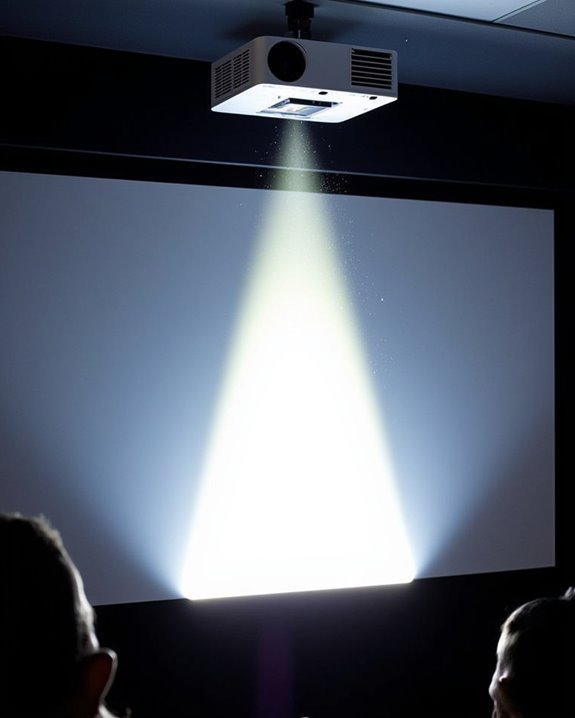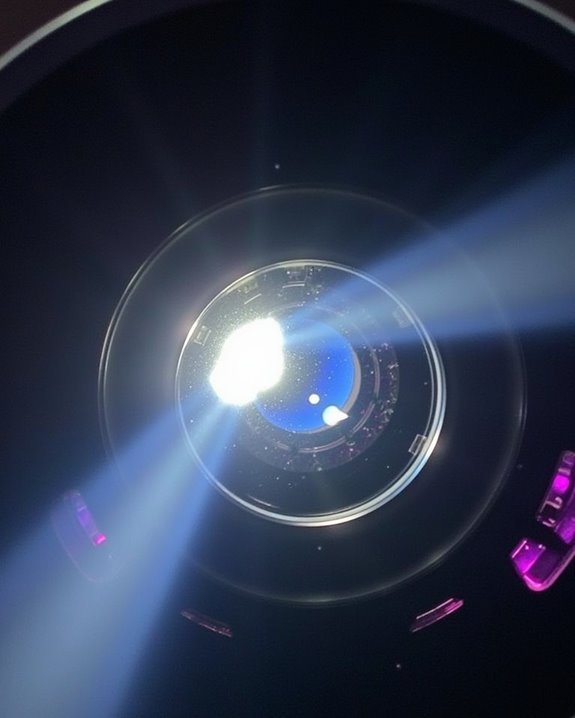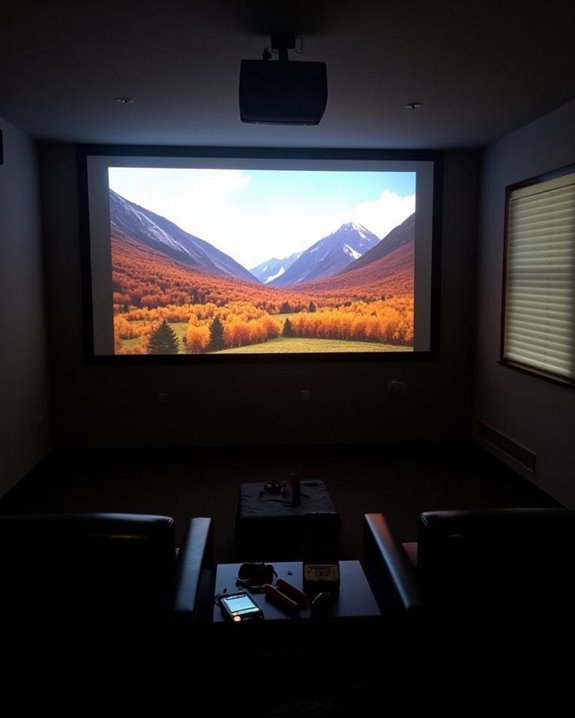When you consider projectors, it’s important to know that they do have refresh rates, which describe how often the image updates per second, measured in Hertz (Hz), with most standard models operating at 60Hz and advanced units reaching up to 120Hz or higher for smoother visuals. This specification affects motion clarity, flicker reduction, and overall viewing experience, especially for fast-moving content or interactive use, making it a key factor when evaluating projector performance for different purposes. Understanding how refresh rate interacts with other display elements can help you make more informed choices.
Key Takeaways
- Yes, projectors have refresh rates, typically measured in hertz (Hz), indicating how many times the image updates per second.
- Standard projector refresh rates are usually 60Hz, with advanced models supporting 120Hz or even 240Hz for smoother motion.
- Higher refresh rates in projectors reduce flicker, motion blur, and visual artifacts, improving overall image quality.
- Refresh rate is determined by the projector’s hardware and works independently from the frame rate of the source video.
- Modern projector advancements focus on increasing refresh rates to enhance motion clarity, especially for gaming and fast-paced content.
What Is Refresh Rate in Projectors?
When considering how projectors display images, it’s important to understand what **refresh rate means and why it matters. Refresh rate, measured in hertz (Hz), tells you how many times per second your projector updates the entire image on the screen, directly influencing smoothness and clarity. A standard projector typically operates at 60Hz, refreshing the image 60 times each second, which is adequate for presentations and movies. Higher refresh rates, like 120Hz or 240Hz, are essential for gaming or fast-motion video, as they reduce flicker, motion blur, and enhance noise reduction for a more comfortable visual experience. Maintaining a suitable refresh rate also supports color accuracy** by ensuring consistent image updates, helping your projector deliver lifelike and immersive visuals across various applications. Over the years, refresh rates have doubled approximately every ten years, reflecting ongoing advancements in projection technology. Additionally, modern projectors often incorporate auto keystone correction and electric focus features to maintain image quality during dynamic use.
How Refresh Rate Differs From Frame Rate
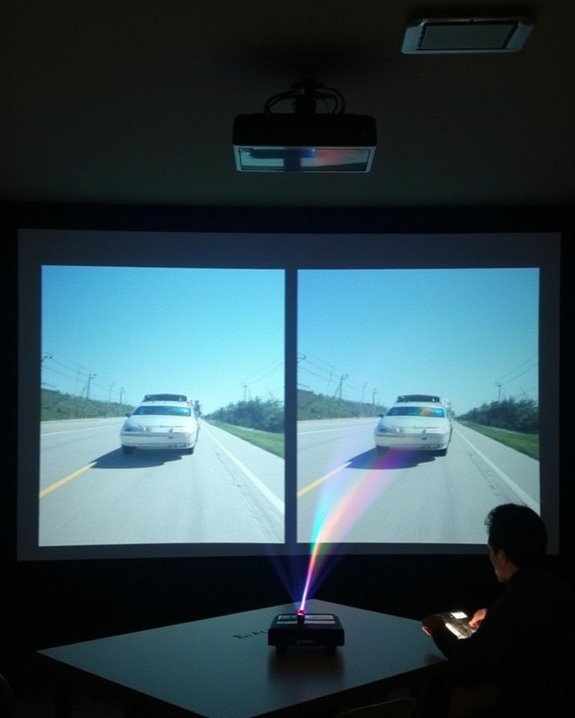
Although refresh rate and frame rate are often mentioned together in discussions about visual technology, it’s important to recognize that they refer to two distinct aspects of how images are displayed on a projector. Refresh rate, measured in Hertz (Hz), tells you how many times per second the projector updates its image, while frame rate, measured in frames per second (FPS), shows how many unique images are provided by the content source. To clarify the differences, consider these key points:
- Refresh rate is limited by the projector’s hardware; frame rate depends on your media source and device processing power. Modern projectors often support 4K resolution at 30Hz, which influences the maximum refresh rate available.
- Higher refresh rates improve motion clarity, color accuracy, and reduce ghosting, but may also increase power consumption.
- Frame rate primarily impacts the smoothness and realism of motion.
- Mismatched rates can result in screen tearing and suboptimal visual experiences.
- The best visual experience is achieved when the frame rate provided by your content closely matches the projector’s refresh rate, ensuring smooth and artifact-free playback.
Typical Refresh Rates Found in Projectors
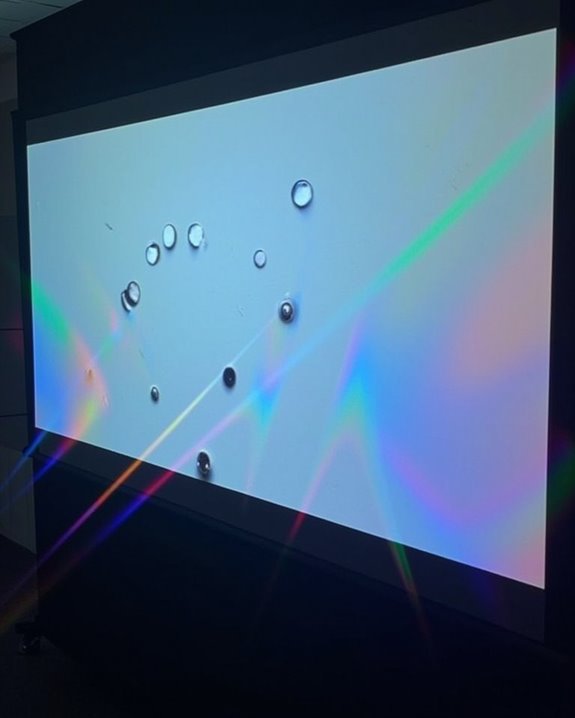
Understanding how refresh rates are implemented in different projectors helps you choose a model that fits your needs, whether you’re watching movies, giving presentations, or aiming for smooth gaming performance. Most basic and legacy projectors operate between 30Hz and 60Hz, which matches typical video sources and is suitable for standard viewing while minimizing power consumption and cost. Because refresh rate directly impacts the overall quality and feel of projection, selecting the right refresh rate can make a noticeable difference in how smooth and lifelike your visuals appear. Additionally, pairing your projector with the right screen gain and surface can enhance perceived motion clarity and brightness.
Mid-range and gaming projectors often provide 120Hz refresh rates, allowing for smoother motion in fast-paced content, with improved color accuracy and reduced input lag—crucial for gaming. High-end projectors may support up to 240Hz at 1080p, offering exceptional motion clarity for esports and dynamic footage. Film-based projectors use flicker rates like 48Hz or 72Hz via shutter mechanisms, ensuring stable, flicker-free images distinct from digital models.
Impact of Refresh Rate on Visual Quality
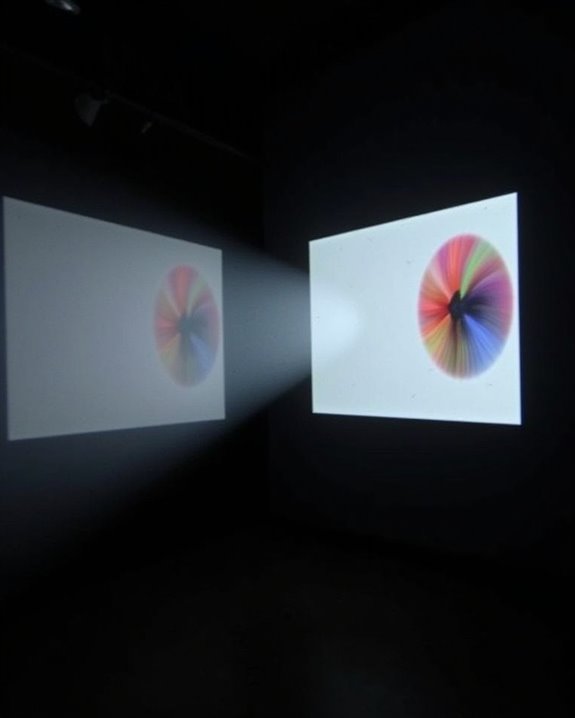
Because refresh rate directly determines how often your projector updates the image each second, it plays a crucial role in shaping the overall visual quality you experience. A higher refresh rate enables smoother shifts between frames, which is especially important for motion clarity and maintaining color accuracy during fast-moving scenes. When the refresh rate is too low, you may notice choppy visuals, motion blur, or even flickering, all of which can degrade your viewing experience. Proper synchronization of frame rate and refresh rate ensures that smooth, clear motion is maintained and reduces the risk of visual discomfort. To help you understand the specific impacts, consider the following:
- Higher refresh rates reduce motion blur, enhancing motion clarity in dynamic scenes.
- Improved refresh rates maintain color accuracy, preventing color trailing or smearing.
- Lower refresh rates increase the likelihood of visual artifacts, such as flicker and judder.
- Consistent frame updates help preserve detail and image stability during rapid movement.
Refresh Rate Needs for Different Activities
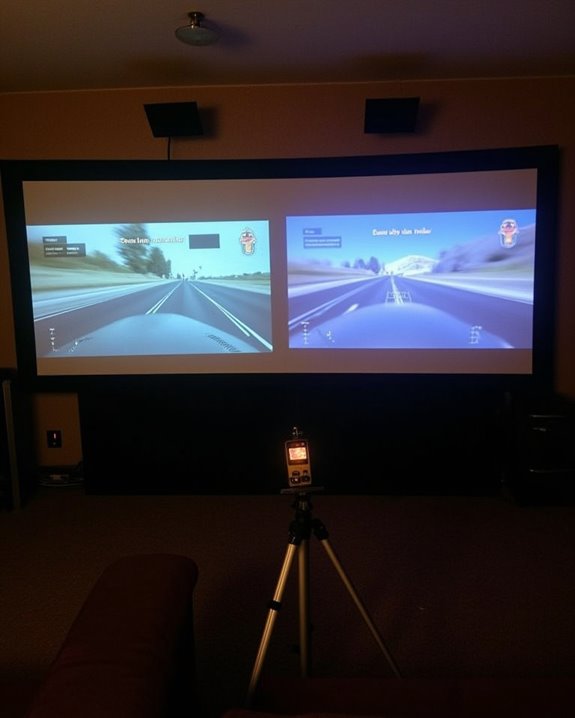
Different activities place unique demands on a projector’s refresh rate, so it’s important to match your device’s capabilities with how you plan to use it. For movies and TV shows, a 60Hz refresh rate is generally sufficient, as most content runs at 24fps or 30fps, ensuring smooth playback without unnecessary power consumption. Presentations, which focus on static slides and text, also benefit from a 60Hz rate, where color accuracy and image clarity matter more than high motion handling. If you’re interested in simple games, a 60Hz projector works well, but graphics-intensive gaming or high-speed action videos require at least 120Hz or higher for reduced motion blur and improved visuals. Higher refresh rates can increase power consumption, so consider your typical usage when choosing a projector.
Technical Factors Affecting Refresh Rates
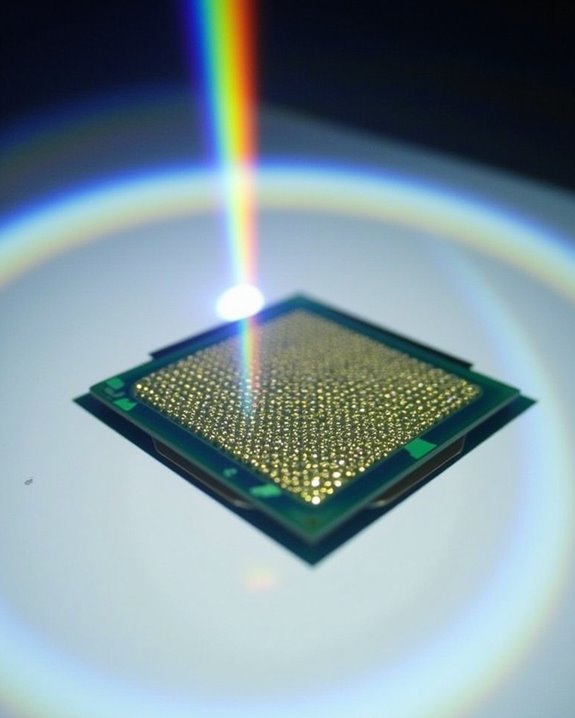
Although refresh rate might seem like a straightforward specification, several technical factors work together to determine how smoothly a projector can update images on the screen. The refresh rate you experience depends not only on the projector’s advertised capabilities but also on the underlying technology and how efficiently it processes and displays visual data. You’ll notice that color accuracy and power efficiency are directly affected by these choices, as are overall performance and image quality. For gaming, low input lag/latency is just as important as refresh rate, because a delay between what you do and what you see can seriously affect your performance. Here are four main technical factors to contemplate:
- Hardware Capabilities: The projector’s internal components set the maximum achievable refresh rate.
- Signal Processing Speed: Faster processing enables higher refresh rates, ensuring minimal input lag.
- Display Technology: DLP and LCD projectors differ in how they handle refresh rates and maintain color accuracy.
- Power Consumption: Higher refresh rates may reduce power efficiency, increasing energy use.
Comparing Projector and Monitor Refresh Rates
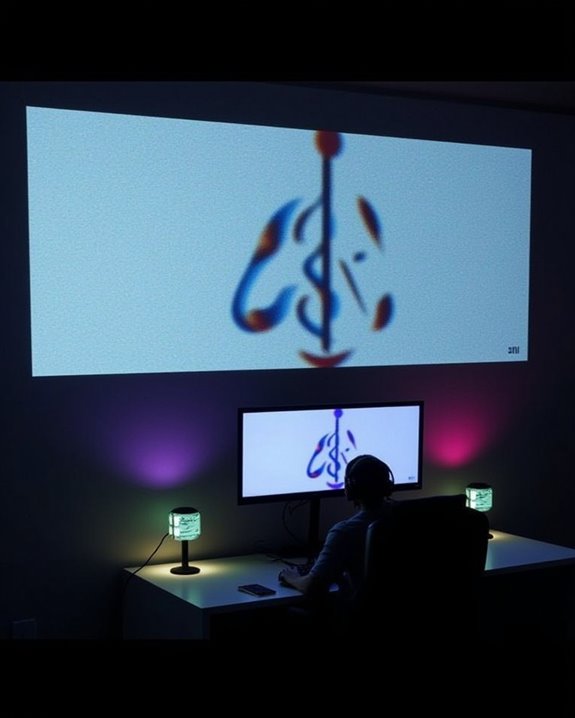
While both projectors and monitors use refresh rates to determine how smoothly images update on the screen, there are important differences in how these devices deliver motion clarity and overall visual performance. Projectors typically offer much larger screen sizes than monitors, which can enhance immersion but may impact color accuracy depending on lens quality and ambient lighting conditions. Monitors, on the other hand, generally provide sharper resolution and superior color accuracy due to advanced panel technologies and smaller pixel sizes. Both projectors and monitors can achieve high refresh rates, such as 240Hz, supporting smooth visuals for movies, sports, or gaming, yet monitors often deliver lower input lag, making them preferable for competitive gaming. When comparing devices, consider screen size, lens quality, and your needs for motion clarity and color fidelity. For gaming in well-lit rooms, monitors generally perform better than projectors unless you have a high-lumen projector designed to handle ambient light.
Advancements in Projector Refresh Rate Technology
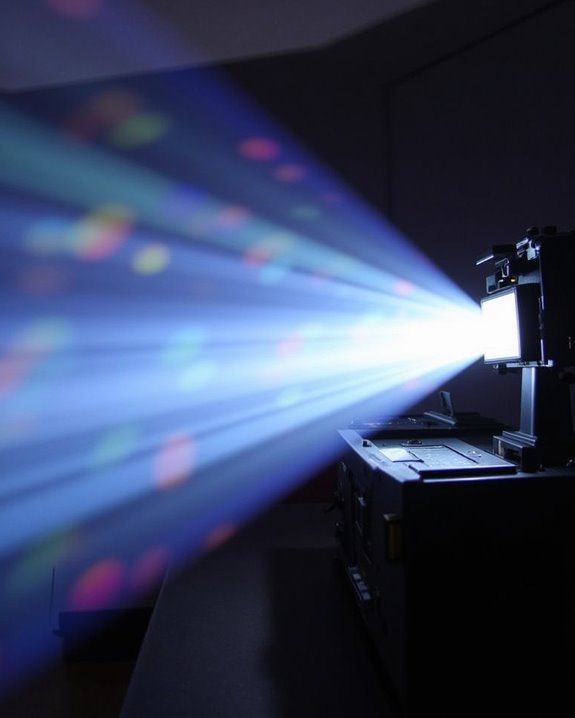
As projector technology has progressed, refresh rates have advanced from the early standard of 30Hz to modern capabilities reaching up to 240Hz, allowing projectors to deliver smoother and more responsive visuals. You’ll notice that most current projectors operate at 60Hz, which is sufficient for standard videos and presentations, but higher rates are essential for gaming and fast-paced content. Key advancements in projector refresh rate technology you should know about include:
- Integration of MEMC technology, improving motion handling at 60Hz.
- Enhanced panel technology, resulting in better color accuracy and higher resolution.
- Support for higher refresh rates, such as 120Hz and 240Hz, ideal for gaming and sports.
- Adaptive adjustments to maintain performance under varying ambient light conditions.
These improvements combine to deliver a clearer, more immersive viewing experience. Increasingly, manufacturers are focusing on gaming-focused projectors that offer optimized refresh rates and low input lag to meet the demands of modern gamers.
The Future of Refresh Rates in Projector Design
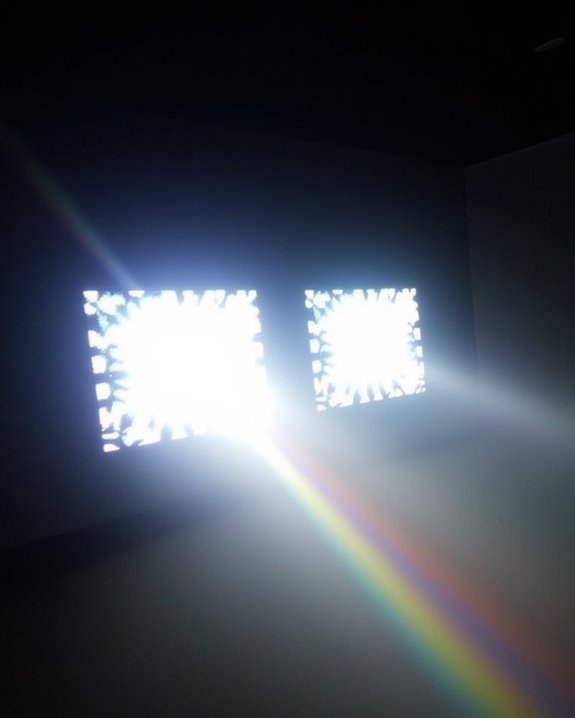
Projector refresh rates are set to play an increasingly critical role in shaping the next generation of visual technology, as manufacturers focus on delivering smoother motion and sharper images to meet the demands of advanced applications. As projection speed increases, you’ll notice far greater image stability, especially in environments where real-time tracking or interactive projection mapping is essential. Future projectors will likely support refresh rates of 240 Hz or higher, facilitating seamless integration with gaming, sports simulators, and immersive exhibitions. These advancements also align with the move toward higher resolutions like 8K and 16K, ensuring that rapid motion remains clear without blur. Enhanced projection speed and image stability will work in tandem with AI-driven features, advanced connectivity, and energy-efficient laser technology, reshaping both professional and entertainment experiences. Projectors using 3 LCD projectors or 3-chip DLP technology already deliver vivid, detailed images and high reliability—an ideal foundation for supporting the higher refresh rates and resolutions of tomorrow.
Frequently Asked Questions
Can You Manually Change the Refresh Rate on a Projector?
You usually can’t perform a manual adjustment of the refresh rate settings on a projector. Most projectors have fixed refresh rates, so you won’t find the same flexibility for changing settings as you would with monitors.
Do All Cables Support High Refresh Rates for Projectors?
Imagine trying to run 4K 120Hz on your projector with a basic HDMI cable—it just won’t work. You’ve got to check cable compatibility because not all cables overcome refresh rate limitations, especially for high-performance applications.
Does Ambient Light Affect the Refresh Rate of a Projector?
Ambient light doesn’t change your projector’s refresh rate, but it can impact image clarity and perceived brightness. If your room’s too bright, the picture may look washed out, even if the refresh rate remains constant.
Are There Projector Brands Known for Higher Refresh Rates?
You might think all projectors are similar, but when it comes to refresh rate compatibility and brand performance, BenQ, ViewSonic, Optoma, and Epson stand out for offering higher refresh rates, making them ideal for gaming and smooth visuals.
Can Firmware Updates Increase a Projector’s Refresh Rate?
You’ll find that firmware improvements can’t actually increase your projector’s refresh rate beyond its hardware limits. While updates might reduce input lag or release hidden modes, the true refresh rate is always set by the projector’s internal design.


